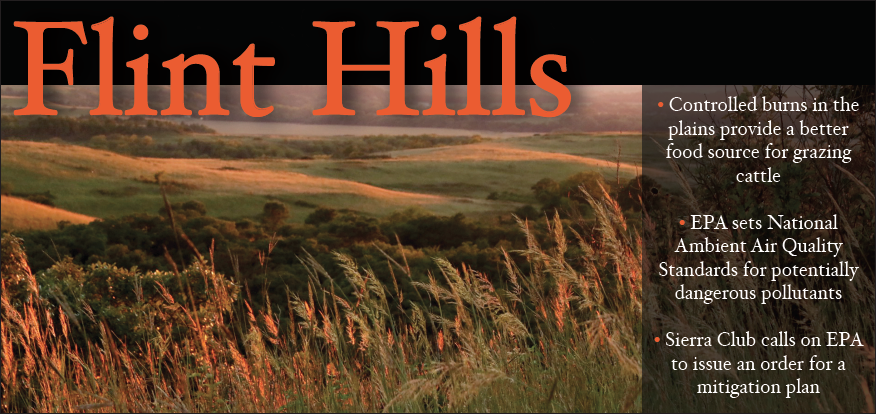Sierra Club seeks controlled burn reform
January 16, 2017
Sierra Club’s Kansas Chapter, a grassroots environmental organization, calls on Region 7 of the U.S. Environmental Protection Agency to reform current field burning practices in the Flint Hills.
Seasonal burning is a long running practice that serves an important agricultural function. According to the Kansas Department of Health and Environment, controlled burns in the plains provide a better food source for grazing cattle and protect the land from invasive species.
“In addition to destroying the invasive species, the prescribed burning practice provides a filter for freshwater, prevents soil erosion, provides wildlife habitat for grassland birds such as the prairie chicken, mitigates nutrient loading and protects against chances of dangerous wildfires,” said Ashton Rucker, public information officer for environment programs at KDHE.
Although there are many benefits to field burning, it can negatively affect air quality if not properly managed. EPA sets National Ambient Air Quality Standards for potentially dangerous pollutants. These pollutants become harmful to public health and the environment when their measurements exceed NAAQS.
Relevant to burning in the Flint Hills are ozone and fine particles. According to EPA, the NAAQS is 70 parts per billion by volume for ozone and 35 micrograms per cubic meter for fine particles.
Craig Volland, chair of the Kansas Chapter’s Air Quality Committee, provided a publicly available record of NAAQS exceedances attributable to rangeland burning in the Flint Hills. According to this record, a number of exceedances of ozone and fine particles occurred in Kansas, Missouri, Nebraska and Oklahoma in the current decade.
According to another document provided by Volland, health effects of ozone and fine particle exceedances include reduced resistance to respiratory infection, emphysema, bronchitis, cardiovascular inflammation, cardiac arrhythmia and heart failure.
KDHE states Kansas has not been in violation of NAAQS.
“Our data show that Kansas is in compliance with the ambient air quality standards for smoke generated from burning,” Rucker said.
Volland, however, believes this data is misleading. EPA implemented the Exceptional Events Rule in 2007. This rule exempts certain exceedances from being considered a violation of NAAQS. Exceptional events include natural events and human activity that is unlikely to recur. This rule also considers controlled burning an exceptional event so long as it is performed under a smoke management plan.
This exemption is based on the existence of a plan, rather than the effectiveness of a plan and Sierra Club considers Kansas’ plan a failure.
“Since the issuance of the December 2010 smoke management plan, there have been 27 exceedances in five burn seasons excluding 2013 when drought in 2012 meant there was no grass to burn,” Volland said. “This compares to 17 exceedances in the previous five burn seasons.”
Sierra Club also criticized a lack of transparency in the plan. Sierra Club’s open letter to Mark Hague, administrator of EPA Region 7, states KDHE’s smoke management plan has yet to be updated or publicly reviewed in the six years it has been in place.
Because of these issues, Sierra Club calls on EPA to issue an order for a mitigation plan to update and improve the 2010 smoke management plan. Volland suggests extending the burn period beyond the last few days of March and the first three weeks of April as one way to improve the situation.
“This could be achieved simply, for example, by designating when counties in the region are allowed to burn over, say, a six or eight week period, or possibly staggering the burning within the big burn counties by township,” Volland said. “There are other possibilities. We think the new patch burn technique would help and it certainly would protect grassland birds.”
In spite of Sierra Club’s criticism, KDHE stands by the current smoke management plan, which KDHE developed with the help of ranchers, the Kansas Department of Agriculture and EPA.
“The Department has made tremendous efforts to help the rancher community minimize potential impacts from burning and will continue to do so,” Rucker said. “For example, fields have traditionally been burned off in early April. In the last several years, we have encouraged ranchers to spread this time out, including by burning in March. Every year, more and more acres are being burned in March, greatly minimizing the amount of smoke that can be generated in any given day.”
KDHE also created a weather-predictive model indicating the best days to burn, along with days that should be avoided. This model is easily accessible to ranchers.
Aside from the smoke management plan, Sierra Club also raised concerns with the way air quality is monitored in Kansas. Among their concerns are the lack of an ozone monitor between Topeka and Cedar Bluff, a fine particles monitor between Kansas City, Kansas and Cedar Bluff and a fine particles monitor north of Wichita.
Furthermore, according to Sierra Club, a heavy smoke plume originating in the Flint Hills during the 2016 burn season remained undetected until it reached Lincoln, Nebraska. Sierra Club believes current monitoring systems are inadequate in protecting populations outside of large cities.
KDHE insists it is taking all necessary steps to ensure public health.
“Over the years, KDHE has worked and will continue to work with the surrounding states to solicit their input on this process, which has been incorporated into the smoke management plan and the sharing of program information and data,” Rucker said.
Volland remains skeptical.
“In their 2010 [smoke management plan], KDHE said they were going to do a health impact study in cooperation with the [Center for disease control and prevention], but they never followed up, claiming that the funds were allocated by the CDC elsewhere,” Volland said. “This is inexcusable in my view.”



